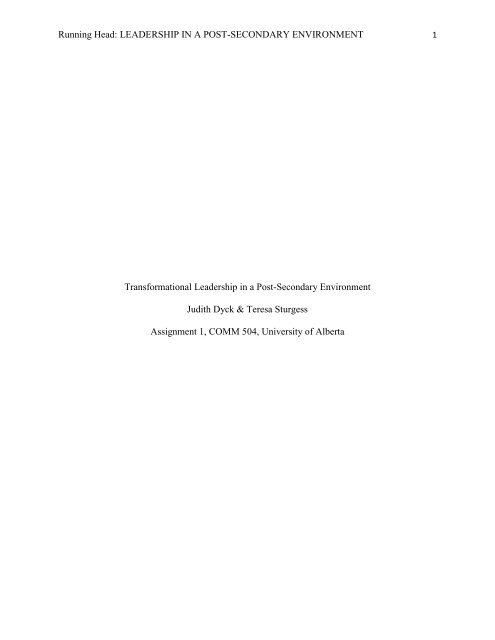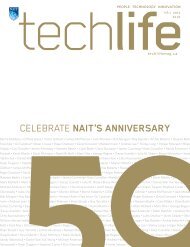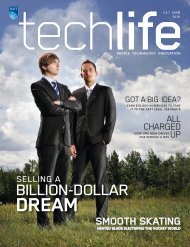fulltime
Transformational Leadership in a Post ... - techlife magazine
Transformational Leadership in a Post ... - techlife magazine
You also want an ePaper? Increase the reach of your titles
YUMPU automatically turns print PDFs into web optimized ePapers that Google loves.
LEADERSHIP IN A POST-SECONDARY ENVIRONMENT 2Transformational Leadership in a Post-Secondary EnvironmentHistory, Mission, Structure and ProductsEstablished in 1962, NAIT is Canada’s largest apprenticeship trainer and one of itsleading polytechnic post-secondary institutions. NAIT’s mission is to deliver educated, skilledand successful learners in science, technology and the environment, business, health care and thetrades (“About NAIT,” n.d.). NAIT has more than 8,000 <strong>fulltime</strong>students enrolled within eight different schools. Its 250credit programs lead to baccalaureate degrees, applied degrees,diplomas and certificates. It also has the capacity to train“To be globally valued for studentsuccess, applied research andinnovation.”NAIT’s VisionNAIT Academic Plan 201215,000 apprentices in over 30 trades (“Quick Facts,” n.d.).NAIT offers 1,400 continuing education courses and engages with business and industry inapplied research and innovation, providing corporate training world-wide. (“ExpandingEducation,” n.d.).NAIT operates in a complex and unstable environment (Daft & Armstrong, 2012, p.144). Its challenges include:vast disparity of curriculum within its schoolsincreasing reliance on current technologiesfunding constraints30 percent enrolment increase over three yearsaging infrastructure and restricted capital fundingcompetition with the private sector for instructors with industry experienceincreasingly competitive global education market(“NAIT Comprehensive Institutional Plan,” n.d.)
LEADERSHIP IN A POST-SECONDARY ENVIRONMENT 3NAIT is self-governed by a Board of Directors which includes staff, student andstakeholder representation. The Board gives direction to the Executive Committee, comprised ofthe CEO, VP Academic and Provost, Chief Financial Officer and VP External. A Counciladvising the President on matters of strategic significance to NAIT includes the ExecutiveCommittee, Associate Vice Presidents, Deans, Directors and the Registrar (“Governance,” n.d.).Organizational Concept: Transformational LeadershipDr. Glenn Feltham became NAIT’s sixth President and CEO on March 1, 2011. Thispaper assesses the first year of Feltham’s transformational leadership style and thecommunication strategies he is using in his quest to transform NAIT into “the most relevant andresponsive post secondary institution in Canada, and . . . one of the world’s leadingpolytechnics” with a “culture based on inclusion and engagement, delegation, andempowerment” (Feltham, 2011).Transformational leadership seeks to bring about significant change in people andorganizations using inspiration and vision, and motivating people to move beyond self-interestfor the greater good. Warrick (2011) says “greatness comes from leadership” (p. 12).Transformational leadership skills include adeptness in leading, championing change andbringing about transformation. Leading includes setting a vision, goals and values; andexemplifying the change envisaged. Championing change includes sponsoring change activities,providing guidance and smoothing the way for change initiatives. Finally, transformationrequires assessing the organization pre-change, identifying and communicating the desiredfuture, and “knowing how to build a healthy, high performance, self-renewing organization”(Warrick, 2011, p. 24).
LEADERSHIP IN A POST-SECONDARY ENVIRONMENT 4Daft and Armstrong (2012) highlight leadership as key to managing organizationalchallenges in a changing environment; leaders must not only respond to, but also create theirorganization’s future. Transformational leadership is particularly effective in creating acompelling vision and environment that encourages risk taking and the exchange of ideas (p.417).Information GatheringDowns and Adrian (2004) describe the assessment or audit process undertaken as one of“exploring, examining, monitoring and evaluating something” (p. 6). Information on Feltham’scommunications initiatives was gathered by reviewing internal and external communicationmaterials and key initiatives, including the creation of a vision of NAIT in 2021 and an updatedacademic plan (Feltham, 2011; “New Academic Model,” n.d.). In an interview, Dr. Feltham alsoshared his perspectives on creating culture, leadership and what success looks like as a leader.The communication audit and interview plans are included as appendices.AnalysisFeltham first undertook strategies to “understand present realities” (Warrick, 2011, p.24). Feltham described finding a hierarchical management structure and culture at NAIT.Programs existed in silos, and employees didn’t have a strong sense of programs outside theirparticular area. To begin creating a horizontal communication culture, which he describes asnoisier because it encourages discussion, he used a mix of formal and informal engagementstrategies. Feltham started walking around a couple of hours each day, talking to people inhallways, offices and wherever he found them. He ate in workrooms with custodial staff and incafeterias with employees and students (Feltham, personal communication, February 14, 2012).
LEADERSHIP IN A POST-SECONDARY ENVIRONMENT 5Within eight weeks of arriving, he initiated the first Annual Employee EngagementSurvey with this promise: “Great organizations ask their people for feedback, and then react towhat they learn. They do so to become better and to create outstanding work environments”(”Employee Engagement,” n.d.). The survey received 1073 responses, a remarkable 40%response rate (C. Davis, personal communication, March 9, 2012).Feltham also launched Project President, taking a hands-on approach to learning aboutthe NAIT student experience by participating in 35 programsfrom four different schools during his first nine weeks at NAIT.While his primary objective was to introduce himself to theinstitution, he also wanted the institution to get to know itselfbetter (Feltham, personal communication, February 14, 2012).Project President was highly publicized: It was the subject of aseries of stories on the campus website, numerous blogs by thePresident on the intranet and external publicity from local and‘Eric De Champlain, a 22-year-oldstudent in the metal worker class,said he appreciates Feltham hastaken a step down frommanagement to look at the work ofa tradesperson. "There is such adisassociation betweenmanagement and trades work, nomatter where you go," said DeChamplain.’M. HarveyEdmonton Journal05 Apr 2011: A.1.national print/radio media (Cummins, 2011; Harvey, 2011). Apictorial essay on the project was preserved in a hardcover book that prominently featuresemployees and students. Warrick (2011) says that transformational leaders model theengagement they envision for the organization (p. 15). Feltham used Project President todemonstrate his commitment to students, passion for education, willingness to learn, and notleast, his skill in using multiple communication channels to reinforce the messages.Another aspect of transformational leadership is inspiring and building trust by sharingresults and taking action. At NAIT, an employee engagement section now permanently appearson the intranet. It details survey results, including every verbatim comment made by staff,
LEADERSHIP IN A POST-SECONDARY ENVIRONMENT 6Feltham’s personal summary of research and action, and a commitment to act on top issuesincluding cleanliness and parking. Other measurable actions include a new program to replaceeveryone’s computer every three years, accompanied by Feltham’s message that employeefeedback reinforced the importance of using the latest technology at a technology institute(“NAITLine,” n.d.). Feltham continues to roam the halls talking to people. The informationnumber for a Family Day event was his direct line that, to the surprise of staff, he answeredhimself. The communications audit also recorded Feltham’s participation in 30 town hall forumswith NAIT employees. In a further step to help students and staff understand NAIT better, newphotos have been posted on hallway walls to provide a snapshot of what takes place on the otherside of each wall (Feltham, personal communication, February 14, 2012).Feltham described initial reaction to his leadership style as sceptical, and said “It’s whatpeople think that’s important, not what the leader thinks.” He added that leaders have to acceptwhere people are at and work to change their perceptions through persistence and consistency(Feltham, personal communication, February 14, 2012).Transformational leaders are visionary, and in September, Feltham released a whitepaper, Positioning NAIT, that provides a vision for the institution in 2021 (Warrick, 2011, p. 14;Feltham, 2011). Transformational leaders also champion change and Feltham actively supports aproject led by the Senior Vice-President and Provost aimed at revitalizing NAIT’s academicstrategy (Warrick, 2011, p. 15; “New Academic Model,” n.d.).
LEADERSHIP IN A POST-SECONDARY ENVIRONMENT 7Both projects were accompanied by rigorous internal engagement strategies includingtown hall meetings and workshops to engage people. Feltham believes it’s important to be clearabout the difference between informing and engagement: Engagement is about getting input. Onthe vision project, the engagement strategies included a mural that expressed the vision, aPresident’s video, and information on the intranet’s highly visible engagement area.Engagement on the academic strategy includes 11committees with representation from across theinstitution to ensure broad and effective input. On bothprojects, Feltham made it clear that employee input wasimportant and would affect the outcomes and finalproduct. Once a decision is made, however,“Once you have decided, youinform people. Engagement iswhen you haven’t made adecision.”Dr. FelthamPersonal communicationFebruary 14, 2012engagement is over and informing begins (Feltham,personal communication, February 14, 2012). The engagement process on his vision for NAIThas been underway since January 2012. Feedback is now being incorporated, and all employeeshave been invited to a day-long, information session on April 30, 2012 where the final visionwill be unveiled (NAIT 2021 Employee Engagement Final Report, 2012).The research, creation and communication of these strategic documents and process areexamples of Feltham acting as a change champion; using leadership skills to design, manage andsustain progress at NAIT (Warrick, 2011, p. 15). Feltham says leaders also empower people andthat success is measured in good part by how many leaders are created during their tenure, partof what Warrick (2011) describes as building a high performing organization (p.16). Felthamcautions that empowerment only works if people are allowed to make decisions, even if thedecision is fundamentally different than the one the leader would make. He also believes it’s
LEADERSHIP IN A POST-SECONDARY ENVIRONMENT 8important to seize opportunities, saying “So much of life and leadership is serendipity...it’s whatyou do when something presents itself.” He describes communication in the same way – plan,but be ready for opportunities not predicted at theoutset. “Always plan for twice as much engagementthan you initially thought you needed,” says Feltham,acknowledging how much work it takes to truly“Put your best people on yourbiggest opportunities, not yourbiggest problems.”Dr. FelthamPersonal communicationFebruary 14, 2012engage people (Feltham, personal communication,February 14, 2012).Under Feltham’s leadership, the culture of the institute is shifting from being hierarchicalto one of horizontal, collaborative communication. He describes it as The NAIT Way, a systemof shared values (“The Nait Way,” n.d.). These were affirmed through four value-buildingsessions he initiated institute-wide where attendance grew at each successive event. Felthamalso believes celebration is important to building culture and inspiring people, and he hasbrought NAIT employees together in events including a family-oriented professional baseballgame and a NAIT family pool day.Feltham demonstrates another aspect of leadership: personal commitment and giving ofself (Warrick, 2011, p. 15). Feltham has participated in all employee events, even donning aswimsuit and tackling the pool’s new climbing wall at the family pool day. He blogs. He walksthe halls. He shares his thoughts in one-on-one discussions, town halls and by publishing papers.He doesn’t hide behind his desk or his title.Feltham measures each strategy’s effectiveness. Web analytics are utilized to determinetime spent reading blog messages and unique employee visits. The number and mix ofemployees attending sessions and celebrations is quietly assessed; Feltham cites growing
LEADERSHIP IN A POST-SECONDARY ENVIRONMENT 9numbers of non-academic staff attending functions as an indication of broader engagementthroughout the organization (Feltham, personal communication, February 14, 2012).Conclusions and RecommendationsThe breadth, depth and sustained leadership approach demonstrated by Feltham is havinga measurable effect internally. He is giving NAIT the impetus to transform itself into a worldleadingpolytechnic and helping it develop a new vision and culture of responsiveness andexcellence. He is using the leadership, championing and transforming skills outlined intransformational leadership theory to carry out his mission as president (Warrick, 2011, p. 24).His approach reflects a commitment to democracy, authenticity, transparency, engagement andempowerment.Academic organizations are traditionally conservative, testing hypotheses and new ideasfor validity (Levin, 2000). They are not typically organized for responsiveness, flexibility, andstrategic positioning, qualities of a transformative environment (Recardo, Molloy, & Pellegrino,1995-1996). By analyzing Feltham’s leadership, we learned that while academic organizationssuch as NAIT might be slow to embrace change, transformational leadership can have aprofound impact on culture and engagement in a relatively short period of time. We also learnedthat transformational leadership is hard work and requires a high level of personal andorganizational energy. It demands excellent communication skills and a thorough understandingof communication tactics.As well, transformational leadership appears to be a key component to creating aboundaryless, learning organization. NAIT is transforming into a learning organization asstrategies take hold and internal boundaries dissolve through the impact of initiatives such as the11 cross-functional/cross-disciplinary teams developing the new academic plan (Daft &Armstrong, 2012, p. 415). This enhances NAIT’s chances of achieving its vision: boundaryless
LEADERSHIP IN A POST-SECONDARY ENVIRONMENT 10organizations are nimbler, more responsive and better at generating ideas (Daft & Armstrong,2012, p. 121).Downs and Adrian (2004) stress the importance of upward, downward and horizontalcommunication flows (pp. 53, 54). Feltham’s communication downward is being receivedpositively. By continuing to encourage upward and horizontal communication, Feltham wouldstrengthen two-way and many-to-many dialogue. Tactics he might consider include continuingthe use of formal cross-school leadership teams like those building specific plans to implementthe new academic model, as well as creating new, more informal opportunities like an “AskGlen” column and “Spot Glen” site inviting people to post photos of the president aroundcampus. Both formal and informal strategies will support NAIT’s becoming a learningorganization.Leaders in academic institutions have to be consistent in order to acquire respect withintheir organizations (Middlehurst, 2008, p. 336). Feltham’s challenge will be sustaining thestrong start he has made in engaging everyone at NAIT in the process of transforming theinstitution into a world-leading polytechnic.
LEADERSHIP IN A POST-SECONDARY ENVIRONMENT 11ReferencesAbout NAIT. (n.d.). Retrieved February 6, 2012, from http://www.nait.ca/44322.htmCummins, J. (2011, April 05). NAIT boss heads back to school; Get-acquainted tour seespresident watch animal dentistry, rough it with forestry students; lifelong learning.Edmonton Journal. Print. p. A5.Daft, R. & Armstrong, A. (2012). Organization Theory & Design. U.S.A.: Nelson EducationLtd.Downs, C., Adrian, A. (2004). Assessing Organizational Communication. New York: TheGuildford Press.Employee Engagement. (n.d.). Retrieved March 20, 2012 fromhttps://www.nait.ca/cps/rde/xchg/campuscommunity/web/2960.htmExpanding Education. (n.d.). Retrieved February 6, 2012, from http://www.nait.ca/65667.htmFeltham, G. (2011). Positioning NAIT. Retrieved February 5, 2012 fromhttps://www.nait.ca/ccincludes/docs/Positioning NAIT.pdfGovernance. (n.d.). Retrieved February 6, 2012, from http://www.nait.ca/44471.htmHarvey, M. (2011, September 01). "New president at NAIT.” Interview on Edmonton AM(radio). Retrieved March 2, 2012 from http://www.cbc.ca/edmontonam/2011/09/01/newpresident-at-nait/Levin, J. (2000). The practitioner’s dilemma: Understanding and managing change in theacademic institution. In Hoffman, A., Summers, R. (2000). Managing colleges &universities: Issues for leadership. Westport, CT: Greenwood.Middlehurst, R. (2008). Not enough science or not enough learning? Exploring the gaps betweenleadership theory and practice. Higher Education Quarterly, Vol. 62 Issue 4, p322-339.
LEADERSHIP IN A POST-SECONDARY ENVIRONMENT 12Accessed March 10, 2012 athttp://login.ezproxy.library.ualberta.ca/login?url=http://search.ebscohost.com/login.aspx?direct=true&db=a9h&AN=34527891&site=ehost-live&scope=siteNAIT 2021 Employee Engagement Final Report. (2012). Retrieved March16, 2012 fromhttps://www.nait.ca/ccincludes/docs/NAIT2021Engagement.pdfNAIT Academic Plan. (n.d.). Retrieved February 5, 2012 fromhttps://www.nait.ca/cps/rde/xchg/campuscommunity/web/about-nait.htmNAIT Comprehensive Institutional Plan. (n.d.). Retrieved February 5, 2012 fromhttp://www.nait.ca/docs/CIP2011.pdfNAITLine. (n.d.). Retrieved March 20, 2012 fromhttps://www.nait.ca/cps/rde/xchg/campuscommunity/web/naitline_3693.htmNew Academic Model. (n.d.). Retrieved March 15, 2012 fromhttps://www.nait.ca/cps/rde/xchg/campuscommunity/web/3268.htmRecardo, R., Molloy, K., & Pellegrino, J. (1995/96). How the learning organization manageschange. National Productivity Review, (Winter 1995/96), pp. 7 - 13. Retrieved March 4,2012, fromhttp://web.ebscohost.com.login.ezproxy.library.ualberta.ca/ehost/pdfviewer/pdfviewer?vid=10&hid=123&sid=651a4a2f-f1e8-41f9-ac31-6b925514219d%40sessionmgr15The Nait Way. (n.d.). Retrieved March 19, 2012, fromhttps://www.nait.ca/cps/rde/xchg/campuscommunity/web/3541.htmQuick Facts. (n.d.). Retrieved February 6, 2012 from http://www.nait.ca/50198.htm
LEADERSHIP IN A POST-SECONDARY ENVIRONMENT 13Warrick, D. (2011). The urgent need for skilled transformational leaders: Integratingtransformational leadership and organization development. Journal of Leadership,Accountability and Ethics, 8(5), pp. 11-23
LEADERSHIP IN A POST-SECONDARY ENVIRONMENT 1Appendix OneCommunications Audit Plan for Transformational Leadership Review at NAITSource Methodology Timeframe Permissions /ConsiderationsComm 504 Textbook:Organization Theory &DesignFebruary 2, 2012External LiteratureSearchNAIT employeeIntranet sections:-Executive messages-“Glen’s Blog”-Employee Engagement-Streaming videoreview of CEO led townhall sessions andinauguration of CEO-New Academic Model-“NAITline” stories andemployee comments onall communicationrelated to FelthamNAIT producedexternal communicationtoolsFocus on Chapters 10& 11 and specificallyTransformationalLeadership (p. 416)to understand keyattributes andstrategies of thisleadership styleU of A LibraryDatabase search tounderstand, reinforceand build on text bookcontent onTransformationalLeadership-Using theoreticallearning fromliterature scan -reviewall communicationsfrom Glen Felthamfor approach andcontent analysisagainst the theory-Confirmation ofsurvey response ratesin phone conversationwith HR Manager C.Davies, March 9,2012Review hardcopy ande-version of magazine“NAIT Techlife” forAlumni and Friendsof NAIT for articles/messages from theCEO. Two issuessince his arrival.February 2 – 13, 2012From Feltham’s firstday at NAIT and hisfirst communicationon March 1, 2011through March 9,2012March 1, 2011 untilMarch 9, 2012Idea generation forComm 504 Assignment 2idea on Leadership –approval from professorFebruary 9, 2012NAEthics approval fromComm 504 professorFeb 17, 2012NA
LEADERSHIP IN A POST-SECONDARY ENVIRONMENT 2Source Methodology Timeframe Permissions /ConsiderationsExternal publicityreviewNAInterview President andCEO Glen FelthamSearch “Nait in theNews” section ofintranet AND CanadaNewsstand LibraryDatabaseInformal interview inFeltham’s officeBoard Chairannouncement ofFeltham as CEO onDecember 9, 2010until March 9, 2012February 14, 2012-Request for interviewdirected toCommunicationsDirector whorecommended aninterview with Felthamdirectly-Ethics approval fromComm 504 professorFeb 17, 2012NAIT InternalCommunicationsKristen VernonMeeting with Felthamand Kristen todemonstrate analytictools being used oninternal strategiesFebruary 14, 2012-Tour and brief meetinginitiated by Glen Feltham- Ethics approval fromComm 504 professorFeb 17, 2012
LEADERSHIP IN A POST-SECONDARY ENVIRONMENT 3Appendix TwoNAIT Interview PlanGeneralWhen you took over as president, what did you do to assess the state of communicationin the organization? Were there any benchmarks?o Did you have a sense of the culture / environment you were coming into and didthat change your approach/plans.What was your vision for your communication? What goals did you set out for ProjectPresident?How did Project President, Engagement sessions, and Stakeholder research come to be?Internal CommunicationWhat do you see as some of the unique challenges in communicating within NAIT?How would you characterize the different internal audiences? Skeptical? Open? Difficultto reach? Do you have different strategies for each?Do you have any measures that you are using to monitor success?What would successful internal communication look like for you? How would youmeasure success?What kind of feedback are you getting? How are people providing that feedback?External CommunicationWho do you see as the biggest external audiences?What are your biggest communication challenges in reaching them? What is yourstrategy for tackling those challenges?










